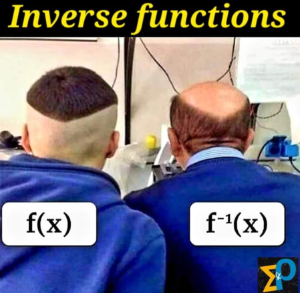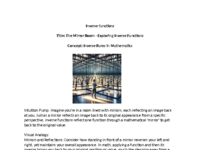Inverse functions
Keywords

| Factual Questions | Conceptual Questions | Debatable Questions |
| 1. What is the definition of an inverse function? | 1. Why does a function need to be bijective (one-to-one and onto) to have an inverse function? | 1. Is finding the inverse of a function more challenging than finding the function itself? Why or why not? |
| 2. How do you find the inverse of the function? | 2. Discuss the graphical relationship between a function and its inverse. | 2. Can the concept of inverse functions be applied to solve real-world problems effectively? |
| 3. What condition must a function meet to have an inverse that is also a function? | 3. Explain the importance of the horizontal line test in determining if a function has an inverse. | 3. Debate the significance of understanding inverse functions in the curriculum. |
| 4. Determine the inverse of . | 4. How does the composition of a function and its inverse relate to the identity function? | 4. Discuss the statement: "The ability to find and use inverse functions is crucial for understanding advanced mathematics." |
| 5. Explain how to verify that two functions are inverses of each other. | 5. Compare the process of finding inverses for linear and non-linear functions. | 5. Evaluate the impact of technology on teaching and learning about inverse functions. |
1. Reflection and Symmetry: - How does the graph of the inverse function relate to the graph of the original function in terms of reflection and symmetry? - Can you find a line over which both the function and its inverse are symmetrical?
2. Intercepts: - What happens to the y-intercept of the original function when you find its inverse? - How does the x-intercept of the function relate to the x-intercept of the inverse function?
3. Intersection Points: - Do the function and its inverse always intersect? If so, where is that point located in relation to the line ? - What is the significance of the point where the function and its inverse intersect?
4. Function Behavior: - How does the slope of the original function affect the slope of the inverse function? - What does the intersection of a function and its inverse tell you about the behavior of the function?
5. Finding Inverses: - How can you determine the inverse of a given function just by looking at the graph? - What changes in the graph when you alter the function's equation?
6. Function Types: - Are there functions that do not have an inverse that is also a function? How can you identify them on the graph? - What characteristics do functions with graphable inverses share?
7. Exploration with Changes: - What happens to the inverse if you change the slope or intercept of the original function? - How can you predict the graph of an inverse function based on the graph of the original function?
Part 2 - Finding the inverse algebraically
If , what is the inverse function ?
If , which of the following represents the inverse function ?
Given , what is the inverse function ?
For the function , identify the inverse function .
![[MAA 2.4-2.5] COMPOSITION - INVERSE FUNCTION.pdf](https://stage.geogebra.org/resource/ttm8qpnp/gyGK0qtrbMhT2Kpm/material-ttm8qpnp-thumb.png)
![[MAA 2.4-2.5] COMPOSITION - INVERSE FUNCTION_solutions.pdf](https://stage.geogebra.org/resource/eagtjcec/ICTelgjYNxfjPbKv/material-eagtjcec-thumb.png)

